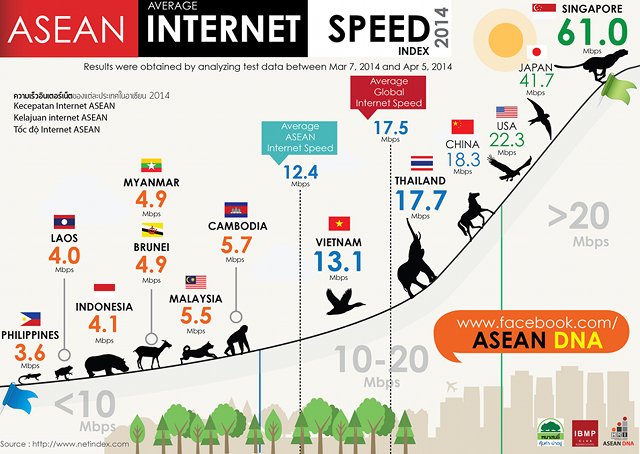There was a time when having an unlimited dial-up account at home is already a luxury. Having access to the internet, even at maximum speeds of only 54Kbps, was the most liberating and addicting as you get instant access to vast information and online services. It was also very expensive — about Php5,500 a month, and unless your job requires and can justify for it, your only other viable option is a Php50-an-hour session at a nearby internet cafe.
All that has changed. We get access to the internet from almost anywhere — the traditional wired DSL at home, fixed wireless for last mile, and 3G or LTE for nomadic use. For really remote areas where no cellular coverage is possible, there’s the option to hook up to satellite internet.
Internet speeds have also gradually improved. From the very first 128Kbps DSL line from 10 years ago, we now can choose anywhere from a basic 1Mbps line to a more generous 10Mbps connection. If you want faster, there are options that go from 20Mbps to 200Mbps but it’s still limited to very few areas in Metro Manila.
Prices have also significantly gone down. The Php5k unlimited dial-up connection is now an equivalent of 8 or 10Mbps DSL or fiber connection.
Of course, as the connectivity service has progressed, the amount of information and content the consumers access have also greatly increased. Back then, there was no Facebook or YouTube. Online games are very limited and HD streaming was unheard of. Websites and portals were pretty basic and light.
All things considered — speeds are up, costs are down — the state of internet in the Philippines have significantly improved. If it didn’t, we won’t be labeled as the social media capital of the world with almost 92% Facebook penetration, one of the biggest YouTube consumers and producers in the region and become the selfie capital of the world.
Yet, there is this unanimous sentiment that internet access in the Philippines is the slowest and most expensive in the region, and perhaps even the rest of the world. Even independent studies have shown this many times before.

Everything is relative and the few who can afford a Php20,000 monthly service fee for a 100Mbps fiber connection at home would tell you otherwise.
But when we see hard numbers across Asia and globally comparing the average internet speed of the Philippines with other countries, we always lag behind in numbers.
We’re not that ambitious to compare ourselves to the blazing fast connections of Singapore, Hong Kong, Japan and Korea but at least our numbers should be within the range of contemporaries such as Malaysia, Vietnam and Indonesia.
Two sources frequently publish reports about internet speeds. One is Ookla and its very popular SpeedTest website and the other is Akamai that has analytics on everyone that accesses their Content Delivery Network (CDN) mirroring popular sites like Google, Facebook, Yahoo and YouTube.
If we are to interpret the results of their published report, we have to look at and consider two factors:
What is the subscribed internet speed of the users that are being measured?
Most ISPs have varying speed offerings but a significant majority of subscribers are on the lowest tier (1-3Mbps). Hence, this tier will determine the average speed of the whole country if we are to base that on Speedtest.net’s crowdsourced data.
In any case, the number is still reflective of most households in the country.
What is the average purchasing power of subscribers?
How much a typical household allocate for internet service will be reflective of their purchasing power rather than the ISPs capacity to deliver.
If ISPs offer a higher speed for the starting subscription plan, then the general average would also be higher. When providers scrap the 1 to 3Mbps starting plan and just start their services at 5Mbps, our general average would double. The result, however, is that fewer people or households will be able to subscribe to the service.
In other words, the current subscription plans that are being offered by the current set of players are a result of fierce sales and marketing push for bigger market share. There is more opportunity and revenue to be made by converting the remaining 60-70% of the population to subscribe rather thanthan up-selling and providing faster service to the existing subscribers.
However, once market saturation reaches 80-100%, the dynamics will change from subscriber acquisition to subscriber retention. That means service providers will focus more on selling higher speed plans to existing subscribers than selling starter plans to new subscribers.
Overselling, Underserving.
Let’s put this into a simple analogy. An ISP is selling tickets to a movie screening that runs 24 hours. Each ticket costs Php999 and allows you to come in and go out of the theater at any time. It even allows you to hand over the ticket to a friend so that when you are out, they can use the ticket and watch the movie while you are away.
The seating capacity of the theater is 1,000 seats. The ISP sells up to 2,500 tickets in the hope that not all 2,500 will enter and watch the movie at the same time. Besides, each one would probably only watch for 2 hours and not the entire 24 hours. Technically, every 2 hours they can accomodate another set of 1,000 new viewers which puts the ceiling capacity at 12,000 in a 24-hour window.
For a time this was okay — only around 800 to 1,200 people watch the round-the-clock movie at once. During those times where there are 1,200 people, the theater is over-crowded and it is standing-room (congested). It was still bearable as 1,000 gets to sit and only 200 are standing.
As years go by, the types of movies shown become more interesting and lasts longer than 2 hours (FB, YouTube, blogs, etc.). Of the 2,500 tickets sold, almost 2,000 people enter the theater and stay for 8 hours instead of the usual 2 hours. That’s 1,000 people seating and another 1,000 people standing. It’s too crowded and while people can still watch, it is not comfortable and others are blocking people’s view. Some would even stay thw entire 24 hours and hog the seats (ISPs refer to them as the 3% abusive users).
The ISP expands floor space or builds a second floor and adds 50% of its original seat count. There are now 1,500 seats. Theater owner says we now have bigger capacity, hence we can sell more tickets. The booths sell 1,000 more tickets. The seating capacity is increased to 1,500 seats but the tickets are now 3,500. The ISP waits a few years until it recovers the cost of adding the new 500 seats.
That is where we are at — a never ending cycle of adding more seats and selling more tickets.
This is exactly the same as in the airlines industry where carriers are actually allowed by law to overbook tickets by up to 10% (selling 99 tickets to a 90-seater plane). That’s why some people get bumped off of their flights once and a while.
In the ISP industry, there is no such thing as a limit on overbooking. The service providers are allowed to overbook in multiples. If an ISP has a capacity of 1Gbps (1,000Mbps) and it sells that capacity to subscribers at 2Mbps per plan they don’t just divide 1,000Mbps by 2, giving them a maximum of 500 customers paying Php999 each. That 1Gbps pipe might cost them $100,000 a month but they will only make Php499,500 from the 500 customers. A Php4.5 million pipe only making Php500k a month in subscriber fees — that’s not the way they will sell it.
What they will do is sell that 1,000Mbps pipe to as many as 20,000 customers which would net them around Php19,980,000. Of course, giving 20,000 customers 2Mbps each would actually require 40,000Mbps in total despite the fact that 2Mbps needs to be guaranteed. That is where the congestion starts. We go back to the movie theater analogy.
Just one of many reasons.
Now that we have a better picture of how the industry players behave, we can better understand the state of internet in the Philippines.
There are a lot of factors to take into consideration, some more obvious than the others.
1) Topography. The Philippine population is scattered in 7,107 islands so the type of connectivity solutions to cater to all of them will vary. Compared to Singapore or Hong Kong which is just a small land mass, the Philippines’s topography poses a more expensive roll-out of infrastructure. Rolling out an underground fiber line from Vigan to Naga requires huge investment. Add to that additional roll-out of submarine cables just to connect the numerous islands of Visayas (Negros Island, Panay Island, Cebu, Bohol, Samar and Leyte).
It is possible that any single internet provider will have to spend 2,000 – 3,000% more on infrastructure in the Philippines compared to the how much it costs to roll out in Singapore. Yet they both have almost the same subscriber base (Something like 2.5 million home broadband subscribers in the Philippines vs. 3 million home broadband users in Singapore. This does not include nomadic 3G/LTE users.)
This is one of the reasons why many barangays and islands in the Philippines only have weak signal or just GPRS/Edge connection.
No ISP is willing to invest and put up the 3 or more towers it needed to give the appropriate coverage. Hence, they will just put up one tower to serve the 100 to 500 or so potential subscribers in those areas. From a business stand-point, it makes sense — why invest millions on a small island of 1,000 people when only 500 of them will subscriber to you and pay you Php300 a month (ARPU or Average Revenue per User for prepaid SMS and voice).
2) Investment Cycle and ROI. The existing players that have already invested in service infrastructure in the last 5 to 10 years are still waiting for their return on investments from the last upgrade. Until then, they need to increase their market share and average revenue per user in order to hit their annual targets. Since most of the players are public companies, they have to balance their growth and expenditures against their revenue and performance in order to please the shareholders. In short, service providers need to recoup their investments and make a profit before spending some more to improve the service quality and coverage.
3) Lack of Competition. Did you know that in the early 2000, there were more than 300 independent ISPs in the Philippines? Though the market then was mainly just for dial-up, any service provider can easily hook up to the backbone and buy more dial-up numbers to increase their capacity. Hence, competition was fierce to gain and retain subscribers.
Today, with mostly DSL and fixed wireless services, the players have shrunk to just the bigger ones.
Believe it or not, we still have so many Internet Service Providers in the country. They range from cable internet, DSL, wireless (WiMax, LTE) and satellite (Read: All the 7 Philippine ISPs to Choose From) but the problem is they all have to deal with PLDT or Globe for the outgoing pipes. So yes, there is some sort of duopoly in play.
4) Peering and Local Exchange. There is some level of inefficiency when ISPs do not locally peer. Content has to go out of the country and back in order to reach a user instead of making the shortcut and travel locally. It also reduces lag time which is essential for certain services like online gaming and VOIP.
One ISP claims that they built their own backbone over the years and paid for it. It is an advantage that will give them a huge lead over competitors. If they interconnect, that would remove their advantage.
5) Appropriate Legislation. The current set of laws on competition, consumer protection and regulations are not enough or outdated. There’s the Competition Act of the Philippines that has been already enacted into law.
The NTC needs to work faster to resolve issues and penalties to erring ISPs must be updated to give it more teeth. Did you know that NTC is only allowed by law to penalize ISPs up to Php200 per day for failure to deliver service? It’s an old law that needs to be amended.
6) Government Support. The National Broadband Network which was proposed and scrapped many years ago would have been a first step had it not been riddled with controversy. A national budget to provide a bigger backbone or wider network would help alleviate the network coverage.
There is already a bill that is being prepared to come up with a Universal Charge which will collect from ISPs and the funds will be used to build more infrastructure. This is already being done in the power sector (check your Meralco bill for Universal Charge) and you can even see this in your water bills.
We’re seeing some progress but for most consumers, that progress is very slow especially when compared to our neighboring countries.
Just like electricity where our rates are among the highest in the region, internet connectivity is even a more complex problem.
For the mobile internet users, read more about “Why Your Telco Needs To Cap Your Mobile Internet“.

































yap me also victim ng sun cellular wala na nga binigay na recibo, mali pa ang monthly fee, 3x na kong nagrequest sa kanila na palitan ang 700 to 499 wala nagawa now naniningil sila ANG DIYOS ANG KALABAN NIYO SA PANLOLOKO !
Hi Abe! Amazing article. Writing from NYC :) Do you have any actionable steps to start solving the issue? Please shoot me an email. Would love to talk about the internet landscape, and possibly opportunities. Thanks and keep it up!
Internet outage? What outage? Fusion Broadband!
Check this out -> http://www.linkedin.com/hp/update/6122963895687663616
SA SUN BROADBAND
LAGLAG SIGNAL NA
TANIM SAMA NG LOOB PA
SA MGA SUBSCRIBERS NA
NAGBABAYAD NAMAN ON-TIME
PERO WALA PA RING MAAYOS NA SIGNAL.
MAG- COMPLAIN MAN SILA
PERO PARANG WALA DIN LANG
KUNDI BINGI, TULOG O
PATAY MALI LANG ANG SERVICE.
KAPAG BAYARAN NA
HUWAG KANG PAPALYA
KUNDI UUSIGIN KA
KULANG NA LANG
DEATH THREATS MAKAKUHA KA.
HAYOP KA SUN BROADBAND
MAMATAY KA RIN
BUHAY KA PA PERO
KALULUWA MO NASA IMPYERNO NA.
HIYANG HIYA NAMAN KAMI SA IYO
KAPWA MO PILIPINO
INAARGABYADO MO
MUKHA KANG PERA
PUTANG INA KA !!!
INTERNET ACCESS IN THE PHILIPPINES IS SUPER PATHETIC !!!
ISPs LIKE SUN CELLULAR IS THE PRIMARY CULPRIT !!!
F**K THEM ALLL !!!
OMG !!!
WHO EVER THINKS THAT THIS SUN PLAN599 IS OF ANY REAL VALUE WILL BE IN FOR THE BIGGEST HEADACHE OF THEIR ENTIRE LIVES.
WE DECLARE, GIVEN OUR OWN FIRST HAND EXPERIENCES, THAT SUN CELLULAR IS THE BIGGEST & THE WORST LIAR & THIEF IN THE INDUSTRY.
THEIR OBVIOUS SLURS AGAINST GLOBE ARE BUT DESPERATE MEASURES & ARE THE LAST DITCH RETALIATORY ATTEMPTS AT THEIR EFFECTIVE & CREDIBLE “KILLER”. THIS IS HOW UNBUSINESS-LIKE SUN GETS WITH ITS CLIENTS & COMPETITORS.
WITH SMART, THE SUN HAS ALREADY FADED A LONG TIME AGO & IS NOW NEAR DEATH!!!
NOBODY DOES BUSINESS WITH THE DEAD, DOES ANYONE?
WE ALWAYS BELIEVE IN DOING FAIR & HONEST BUSINESS. ANYTHING LESS IS BLATANT DIS-SERVICE.
BUSINESS JUSTICE HAS CAUGHT UP ON THE SUN & IT’S A LIFE SENTENCE.
Does our government’s move on the ZTE broadband deal a few years ago have something to do with what we are in now?
It’s because there’s no other players in the telco field that’ll level down the competition, ahh duopoly
government needs to revive the NBN
it is slow and expensive because of monopoly, greed and corruption.
THE SURE KISS OF DEATH FOR PRESIDENTIABLE MAR ROXAS IS:
TELCOS + NTC = SURE LOST FOR MAR ROXAS…
TO THE FILIPINO MILLIONS WHO ARE VICTIMS TO THIS NTC & TELCOS CONNIVANCE, ITS PAY BACK TIME.
LETS VOTE ANYONE BUT MAR ROXAS FOR PRESIDENT !!!
ITS SO SCARY THAT NTC & THE TELCOS WILL AGAIN CONNIVE FOR MAKING MAR ROXAS WIN IN 2016.
AFTER WHICH, WHAT COMES NEXT?
MORE NTC VICTIMS?
MORE VICTIMS FOR THE TELCOS?
NO MORE… WE WANT CHANGE !!!
EVERYONE… LET ALL OUR VOICES BE HEARD NOW !!!
IT IS IN OUR CLOSE & SOLID UNITY THAT THEY (NTC & TELCOS) WILL ALL LISTEN & CHANGE THEIR EVIL WAYS & FINALLY RESPECT THE FILIPINO CONSUMERS !!!
INDIVIDUALLY BINABASTOS NILA TAYO, PERO KAPAG TAYONG LAHAT AY NAGKAISA TAPOS ANG PROBLEMA, GETS NYO?
REMEMBER THE GREAT NINOY & THE EDSA PEOPLE POWER?
LETS ALL CONVERGE AT THE “INTERNET EDSA”… THE LORD ALMIGHTY IS WITH US ALL !!!
this article is a bunch of excuses. indonesia is a larger archipelago than the philippines yet they have a higher rate. laos is landlocked and trails the philippines in economic standing yet their internet is faster. i expect better from yugatech.
I think you missed the point. Topography is indeed a factor but the basis of your stats have failed to consider the internet adoption rates of these countries. The speeds also doesnt correlate to how developed the infra for each island or across the country. For example, majority of internet users in indonesia could be concentrated in several major cities with established facilities whereas here it’s spread all over the archipelago with varying levels of development. Plus the fact that there a significantly higher number of internet users here which would skew the average.
So you think our suggestion that NTC needs stronger control and government have to support the industry with infra support is useless? Care to provide your own suggestions?
The NTC suggestion is just one paragraph of 1/6 reasons you listed to justify slow internet Abe. Of all the things you wrote, that is one thing I agree with you.
Glad to know that we agree on some things. I would like to hear your suggestions as well. :)
Is the probability of having fast internet at low cost in the Philippines high or low?
“Since most of the players are public companies…” PLDT and GLOBE are private companies. I believe we already have a local exchange maintained by DOST. According to DOST this is free. If only all local ISPs connect to this local exchange, there is no need for local data requests to go out of the country when the the address can be found in the local exchange. This will cut additional legwork and can be faster. In the recent Senate hearings presided by Sen. Bam Aquino, it turned out that only one player refuses to connect to the local exchange, PLDT.
I meant, publicly-listed in PSE. Members of the public can be shareholders.
DOST’s Philippine’s Open IX is free (although technically there are minimal charges). But if you (as an ISP) want to join the IX, Globe would profit by charging you for the cross-connect and co-location as Ph Open IX is hosted at Globe MK2 datacenter. Apart from the questions on its technical capability of the hardware (core switches and the hosting facilities) as well as the people running it, there’s also the question on integrity/neutrality.
Gov’t should build multiple neutral datacenters across the country and supply the resilient/meshed backbone between them. Currently, it is still a challenge for smaller ISPs especially in other regions to interconnect with PhOpenIX in Makati as they would still have to lease transport bandwidth from either PLDT or Globe/Bayan.
DOST should pattern our IXs after hong kong’s HKIX with own building for the datacenter, with very capable hardware and to be managed by really competent engineers.
Why would the theater sell more ticket than the total seat capacity of the cinema? If the demand is high then, build more theater as TRAPOE mentioned. In a corporate world we have a thing called ‘PROJECTION’ :)
Or all this things are scheme? ISP already knew how many possible people are using the internet… And they already knew the fall back of all this things…
All ISPs in the world do oversubscription! An SG based ISP that I’ve worked for has a mere 30gbps aggregate IP capacity but still offering gigabit speeds for their thousands of subscribers but of course you only get that max speed when youre doing synthetic test up to local IX only and youd be lucky to get a tenth of that when connecting to outside SG. If youre using above hundred migs for a couple minutes they would throttle/shut you down you in the guise of “you are being attacked (DDoS)”.
A local ISP on the other hand has tenfolds that aggregate IP capacity but doesnt offer the gigabit speeds even though they also have the access (GPON gigabit fiber) technology to do so.
Cow dung! You can’t add more seats to theatres already full of chairs. The solution is to build more theaters.
you make it with examples of 24-hour cinema, plane tickets more complicated than the providers, it is the very untransparent thats the last thing we want, is it so difficult to supply 5, 10, or 20 mb internet for example, 995 in 1795 and 2595 php to deliver? which is still significantly more expensive than in Europe but that are reasonable download speeds and reasonable prices
GREED? Ang kinita po ng PLDT last year 2014 ay 34.1 Billion pesos, o mahigit pa sa 93,400,000 (93.4 Million) pesos ARAW ARAW.. Bawas na rito ang mga buwis, salary, bonuses, benepisyo, lagay (kung meron man) sa mga congressman, senador, NTC commissioner at lahat ng kagastusan. Ang Globe naman ay kumita ng 14.5 bilyon peso nuong 2014 or mahigit pa sa 39.7 milyon piso Araw araw. Kung ibababa nila ang presyo ng internet ay mababawasan ang limpak limpak na salaping kanilang kinikita. Kung bibili naman sila ng gamit para bumilis ang internet ay mababawasan din ang kanilang kita…. pero hindi naman po sila malulugi. Kaya sa pananaw ko ay KASAKIMAN ang dahilan. Kasakiman ng mga taong may control sa mga kumpanyang ito na kulang ang kompetisyon
Good read.
Bakit hindi mo banggitin ang PLDT na hard-headed in this issue? Take a look at this post in reddit. Mas informative pa ‘to.
https://www.reddit.com/r/Philippines/comments/2aurzq/how_pldt_deliberately_keeps_local_internet
Ayaw nila. Hahaha kunyare neutral.
PLDT is one of the main real problems, but this article seems to want to bury that under a load of conflated stats (that are not as meaningful as this site would like you to think). Go to Reddit if you want a true neutral explanation, without abusing stats to cloud the real culprits.
Yes, we did mention PLDT as one of the problems along with several other reasons. Do you have any other ideas that we can add to the list?
That reddit post have been referenced alot and not to be blunt but whoever originally wrote that piece of sh*t in garena forums has got more than half of “his facts” wrong. Even without a local interconnection, our youtube and other web experience shouldnt have to suffer except when gaming/skyping between PLDT and other ISP subs. Obviously, whoever wrote that doesnt quite understand how the internet works. If your on Bayan/globe or whatever ISP youre on and your youtube video buffers every five sec or so, dont blame PLDT for that. If your ISP has capped your daily usage to 700MB, PLDT has nothing to do with that. If your playing LOL with fellow globe/bayan players and your game lags, PLDT actually has nothing to do with that. Get your facts straight!
Now, it doesnt mean pLDT isnt causing a problem to how the whole system works. Unfortunately, they are leveraging on their dominant provider status to not peer with other local ISPs. But also unfortunately, the de facto standard in any country in the world is for no mandatory peering. Even neutral/public IX like SOX (Sg) have very few members with the biggest players not participating as they have competing IX services of their own. Like PLDT here, they have PhIX and ePLDT with Vitro IX. For phix only eastern i believe is a peer while VIX is exclusive for content providers hosted at vitro like garena. Globe, bayan, sky and others all have peered with VIX but it wont allow participants to peer with each other.
Tama ka dyan Hans, nabasa ko na yang link na yan sa reddit at talagang mas informative at hindi bias!